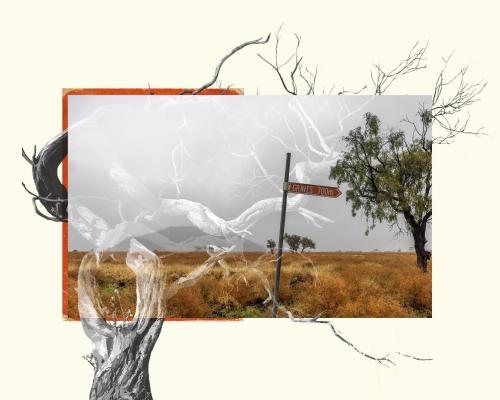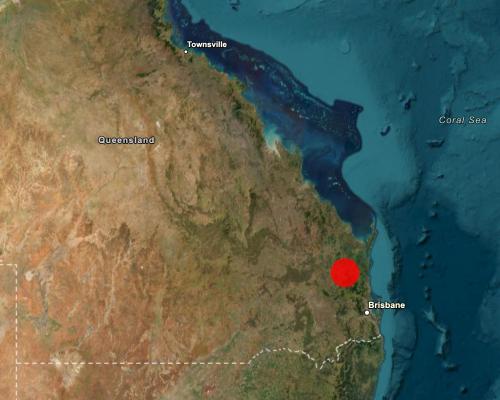
Warning: This article contains historical records that use racist and offensive language, and descriptions of events that will be distressing to some readers
John McPherson catches his breath, his boots caked with mud after trudging 700 metres through a soggy paddock to reach the gravesite.
Light rain falls as he stands before the headstone of his ancestor, whose life ended abruptly on this grassy plain in central Queensland more than a century ago.
McPherson, a former journalist from northern New South Wales, has spent years investigating what unfolded here; a massacre on a lazy afternoon that unleashed a bloody war involving a founder of Australian rules football, the head of Australia’s oldest company and an ancient people whose way of life would be forever altered.
It is almost four years since research emerged suggesting that the sporting legend Tom Wills may have taken part in massacring Indigenous people, sparking internal investigations by both the AFL and Cricket Australia. But this is the first time McPherson, a descendant of the Wills family, has seen the site where the grim saga began.
When the 66-year-old reaches the spot on a damp winter morning, the yellowed grass and sparse trees are shrouded in mist. “It’s got sort of a slightly eerie feel about it,” he says. “Sort of struggling land, and graves.”
Near his ancestor’s headstone is a tree stump with an oval hollow in its trunk. It is a reminder that this was not always a place of death. Once it was a campsite; a gathering place for a vibrant people. The tree, too, signifies a great loss – less spoken about but no less profound – and one that McPherson has travelled 1,000km to acknowledge.
The town of Springsure, about 300km west of Rockhampton, is a gateway to the tourist magnet of Carnarvon Gorge. It is home to 1,000 people and four motels, packed with fluoro-clad workers flown in to service the two nearby coalmines.
Nods to the town’s colonial history are everywhere: a stone monument at the council chambers celebrates the district’s “early pioneers”; sepia photos outside shopfronts show what each looked like in the 1860s; there are even track marks etched into sandstone rocks next to the highway, showing the paths of bullock drays carrying the settlers’ supplies.
Less evident is the history of the Aboriginal people who lived in the region for millennia before colonisation. But their spirit looms in the craggy mountains that tower over the town – in the caves where bones were laid to rest, the sacred ceremony sites and the haunted places that make the hairs of your arms stand on end.
At a bustling lookout to one such mountain, Darryl Black sidles up to an unsuspecting tourist couple from Sydney. “You want me to tell you about the rock?” he asks. They nod politely.
Black, a Bidjara and Ghungalu man, is here most afternoons, enthusiastically telling tourists about the area’s Aboriginal history. He shows them artefacts he’s found in the mountains: axe heads, grinding stones, crude but effective knives chipped from stone – all rattling around in a Coles shopping basket on the back seat of his LandCruiser.
“I’ll tell you the real story – the one that’s not in the history books,” he says.
‘An uncontrolled desire for revenge’
There is plenty in the history books about Springsure – or specifically, about a property a 20-minute drive out of town called Cullin-la-ringo: the site of Queensland’s largest massacre of white settlers by Aboriginal people.
Horatio Wills, a sheep farmer and politician from Victoria, arrived in October 1861 after a gruelling eight-month journey with about two dozen people and 10,000 sheep.
Accompanying him was his son, Tom Wills – a talented cricketer widely considered Australia’s first sporting hero, who co-founded Aussie rules after suggesting the cricketers needed a new game to keep them fit in the off season.
Horatio, who had developed positive relationships with the Djab Wurrung people in Victoria, arrived in central Queensland as long-simmering tensions between the local Aboriginal people and the colonists were about to boil over.
Queensland had been established as a self-governing colony just two years earlier. The frontier was moving north, assisted by the notorious native police – contingents of Aboriginal troopers led by white officers tasked with protecting the livelihoods of settlers and punishing Aboriginal resistance.
The native police had carried out a “string of massacres” and “terrorised” peaceful camps of Aboriginal people in the region in the years before 1861. About the same time there were reports of two Aboriginal boys being kidnapped from the area by white men.
In one notable encounter, just three months before the Wills party arrived, a detachment of native police accompanied Jesse Gregson, the manager of the station neighbouring Cullin-la-ringo, to track down some lost sheep. They found them on the side of a ridge with a local Gayiri tribe.
At least four Gayiri people were shot, according to native police records.
Months later Horatio – who bore some resemblance to Gregson and rode a similar horse – set up camp at what would become his final resting place. Barely a week after the group’s arrival, on 17 October, they were enjoying an afternoon siesta when the onslaught began.
The newspapers listed the names of the 19 dead men, women and children alongside graphic accounts of how they were killed. Horatio was found lying on his back near his tent door, “a deep tomahawk wound in his right cheek – the neck being nearly severed just below the same spot by a large wound, probably inflicted with an axe”.
Sign up: AU Breaking News email
Tom survived. He had been sent to collect supplies from a nearby town days earlier. So did two shepherds, one of whom rode to alert the nearest neighbour – Gregson – of the massacre.
Gregson quickly assembled a group of settlers to bury the bodies. A dispatch from Queensland’s first governor, George Ferguson Bowen, would later describe how “an uncontrolled desire for revenge took possession of each heart”.
The group set out to track the killers.
They found them within days. As dawn approached, they surrounded the sleeping tribe. Official records show at least 30 Gayiri people were killed that day. Then the native police arrived.
‘Many were killed from falling over the cliffs’
“So this is where the native police caught up?” McPherson asks.
He and Black are standing on a quiet road off the highway, looking across a paddock to a small mountain with a sheer cliff face at its peak.
“There were vigilantes and troopers, [they] chased them all the way through this range,” Black says. “They shot them off the end of the hills here. They were in view of their range – that’s what gets me every time. They were nearly home.”
An article published in the Sydney Morning Herald two months later said the native police had shot 60 or 70 people, only stopping when they ran out of ammunition.
“One of the blacks who was shot, cried out, “Me no kill white fellow!” showing plainly they well comprehended the proceeding,” it reads.
Other letters boasted that 300 Aboriginal people had been killed. The exact number of casualties will never be known.
In contrast to the Wills massacre, the details of the Gayiri’s slaughter are scarce. The commanding officer of the native police wrote only: “Their loss was heavy; and I consider that many were killed from falling over the cliffs.”
Guardian Australia and the University of Newcastle’s massacre map shows there were at least six mass killings of Aboriginal people in the months that followed.
The eminent historian Henry Reynolds says Cullin-la-ringo was a turning point in Queensland’s history, paving the way for “warfare” between First Nations peoples and the settlers over control of the state’s north. It would claim the lives of tens of thousands of Indigenous people over the decades that followed. Some groups, including the Gayiri, never recovered.
A Gayiri man, Yamba Konrad Ross, learnt his family had been involved in a massacre during an urgent conversation with his great-uncle on his deathbed.
“He had a lot of old stories and even spoke some of the Gayiri language,” he recalls. “He was emotional because it felt like he needed to teach me as much as he could before he actually passed.”
His uncle spoke of slaughter. Of people hiding in fear.
“There was talk about a cow,” Ross says. “Like dead cows or horses – open them up, pull out the insides and actually hide inside so you couldn’t get found.”
Ross has spent much of his life trying to find out who he is and where his people came from.
His mother grew up on a mission at Woorabinda, away from her country, where she was discouraged from speaking her native language or acknowledging her culture. Her own mother had died young and she didn’t know who her people were.
Ross was raised between Melbourne and Katherine in the Northern Territory. After decades of research, he obtained documents from the Queensland State Archives confirming his ties to the Gayiri people.
In 2008 he went to his country for the first time, spending an unsettling two days in Springsure. “I’m a spiritual person,” he says. “I couldn’t sleep. I was having nightmares.”
Aside from his great-uncle, Ross has been unable to track down many other kin. “The legacy is just a tribe that’s wiped out and forgotten about,” he says.
“It affects me directly because now my family is tiny. People are responsible for decimating a tribe – a tribe of beautiful people – and there’s no repercussions.”
‘They didn’t talk about anything like that’
The memorial site for the Wills massacre is a popular, if grim, tourist attraction. A mowed pathway leads to three graves: one for Horatio; another for the brother of Tom’s former teammate, farmhand George Elliott, and a fellow worker, Thomas; and a mass grave for the rest of the workers and their children.
Horatio’s headstone says the group was “barbarously murdered by the blacks”.
The bones of the Gayiri killed in retribution were left where they fell. There is no memorial for them. The body of one of the dead men, shot while hiding in a tree, was displayed in the Australian and South Sea Islander Museum in Melbourne.
From the early 1900s most of the Aboriginal people who remained in the region were taken to missions or reserves under new laws, ostensibly designed to “protect” Indigenous people – but which placed strict controls over every aspect of their lives and kept them working in conditions tantamount to slavery.
Cullin-la-ringo was taken over by Tom’s younger brothers, Cedric and Horace, who came to blame Gregson for their father’s death. The property was eventually sold but Cedric’s great-grandson, also called Tom Wills, still owns a cattle station adjoining it.
The younger Tom, now in his late 60s, inherited tomes of family letters, journals and memorabilia, which are carefully catalogued and stored in a shed. His grandparents didn’t speak of massacres – “they didn’t talk about anything like that” – but his father had a keen interest in the family history that he passed on to his son.
Tom says the family went on to build good relationships with Aboriginal people, despite what happened at Cullin-la-ringo, later employing them to work on the station.
“They talk about reconciliation – I think reconciliation started in the 1860s,” he says.
Truth-telling shelved
Gregson – who helped slaughter dozens of Aboriginal people in the region – went on to become the longest-serving superintendent of the Australian Agricultural Company, better known today as AACo, a publicly listed $830-million company that controls the country’s largest cattle herd.
Tom Wills the elder, unsuited to farming life, returned to Melbourne. He went on to coach the first Aboriginal cricket team. Alcoholism ended his sporting career and, ultimately, his life. He killed himself in a state of delirium in 1880, aged 44. He was buried in an unmarked grave and disowned by his family.
But the sportsman’s image has undergone a transformation since the release of his biography and a fictionalised account of his life in Martin Flanagan’s 1998 novel, The Call. He is now celebrated as an early pioneer for reconciliation and listed in the Australian Sporting Hall of Fame. There is a statue of him outside the MCG.
There has been much debate over whether he was involved in killing Gayiri people after his father’s death. A researcher sparked a furore in 2021 when he told the ABC he’d found a US newspaper article from 1895 in which an author, known only as “G”, claimed to give an account of Tom’s involvement in a massacre. The Chicago Tribune article, which contained several inaccuracies, quoted him as saying: “I cannot tell all that happened, but know we killed all in sight:”
Several contemporaneous letters appear to support the theory, or at least show Tom’s animosity towards Aboriginal people in the region after the massacre. Four days after returning to its scene, he asks his cousin to send him workers who “will shoot every black they see”. A month later his mother writes to her children that “Tom and the settlers around have well revenged [Horatio’s] death”.
But the younger Tom Wills, and Terry Wills Cooke, another family historian based in Victoria, are adamant that he did not take part in any killings, claiming that family records show Tom was elsewhere – at least during the first retaliation raid.
Guardian Australia understands that the AFL, Cricket Australia and the Melbourne Cricket Club (MCC) commissioned a report by the Indigenous historians John Maynard and Barry Judd. The report, never released but seen by this masthead, was unable to find conclusive evidence to confirm or deny Tom’s involvement in the direct massacre of Aboriginal people – but says “where there is smoke, there is generally fire”. Its authors recommended that the three sporting bodies “lend support” for a “truth-telling process to be undertaken nationally”.
Guardian Australia approached the AFL, Cricket Australia and the MCC for comment, but did not receive a response before publication.
Yamba Konrad Ross accuses the organisations of “trying to shovel the dirt under the carpet and just cover it up with their nice fancy rug”. To move forward, he wants to see further investigation and recognition of the Gayiri people alongside the tributes to Wills.
The younger Tom Wills reckons the characterisation of his ancestor as a trailblazer for reconciliation is an accurate one. Wills Cooke says he was a “very flawed character” and the broader context should be considered when evaluating words and actions from that time. “We tend to judge what happened then as if it was today, but it wasn’t,” he says.
John McPherson, descended from Horatio’s sister, is perhaps the only member of the family to believe that Tom Wills probably did kill Aboriginal people.
He inadvertently stumbled on to the horror of Cullin-la-ringo while writing a thesis about the origins of AFL. His subsequent deep dive into Queensland’s violent past caused him to face significant mental challenges.
“I just read so much material, way more than just the Cullin-la-ringo stuff, about people boasting about their killings,” he says.
“Like this is in the 1890s in Brisbane, people are around having high tea and it’s like, ‘Yes, let’s go out on an Aboriginal hunt this weekend.’ I was just horrified.”
But the experience – and his interactions with Black in Springsure – have strengthened his resolve that these truths should be exposed. “We need to acknowledge our history, because this isn’t all that far in the past and generational trauma is a very real thing,” he says.
Black continues to tell anyone who will listen about the people who were largely eradicated from the land. “I see some of these people, when I’m trying to get them to come along, I see the ones who are a bit standoffish and don’t really want to do it,” he says.
“But then, I love it when these types of people come along, because if you can make change with them, then you know you’re doing all right.”
• Indigenous Australians can call 13YARN on 13 92 76 for information and crisis support; or call Lifeline on 13 11 14, Mensline on 1300 789 978 or Beyond Blue on 1300 22 4636
• Lorena Allam is a professor at the Jumbunna Institute for Indigenous research at the University of Technology Sydney





